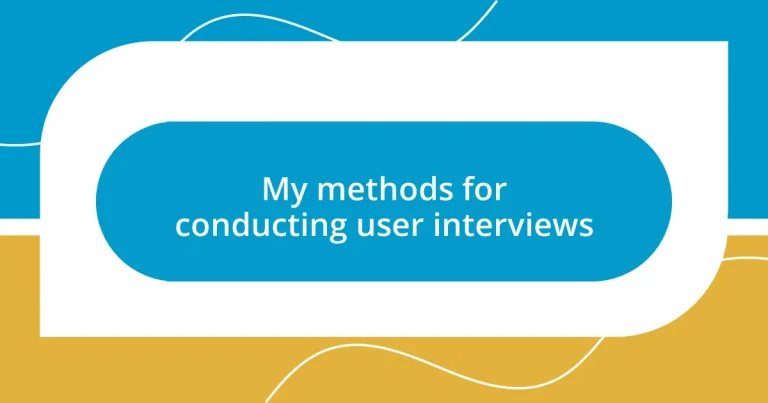Key takeaways:
- User interviews facilitate genuine connections, enhancing the quality of insights through open and flexible dialogue.
- Establishing clear goals and selecting the right participants are crucial for effective, focused interviews that yield meaningful data.
- Applying insights requires balancing analysis with empathy, ensuring user feedback informs both product changes and communication strategies.
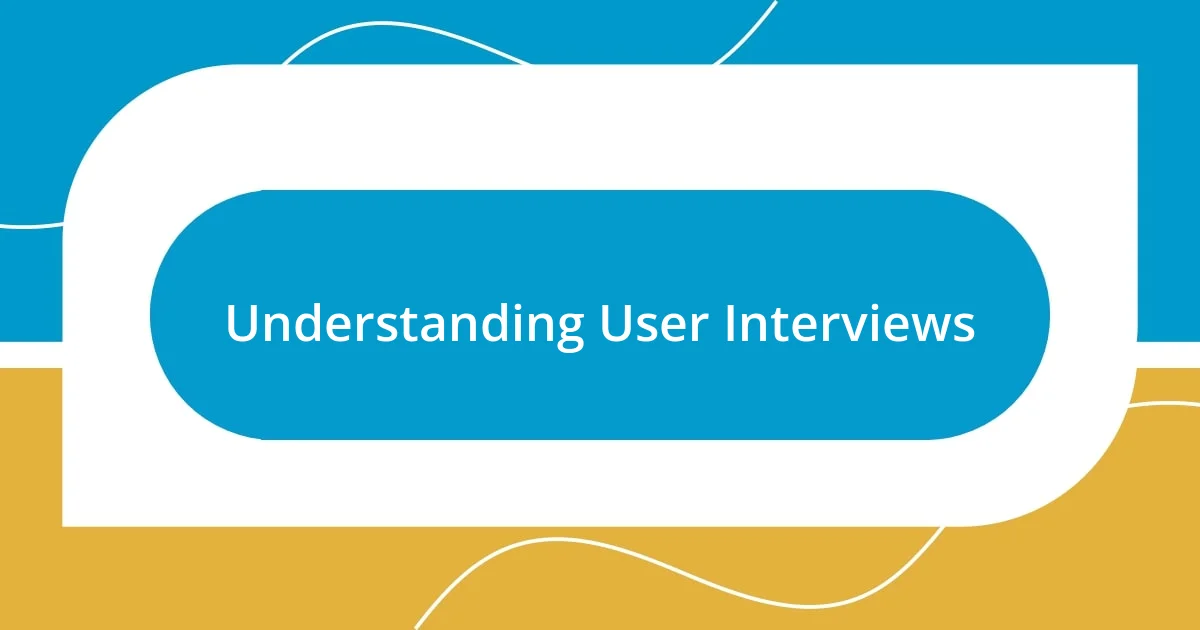
Understanding User Interviews
User interviews are a powerful tool for gaining insights into user behavior and preferences. I remember my first interview vividly; it felt like peeling back layers of an onion. Each question I asked revealed deeper motivations behind user choices, surprising me in ways I hadn’t anticipated. How often do we make assumptions about what users want, only to find out they desire something completely different?
The beauty of user interviews lies in their ability to foster genuine connections and trust. During one memorable session, I found that simply sharing my own experiences helped the interviewee open up. It made me realize that vulnerability is a two-way street; by being authentic, I encouraged them to share more meaningful stories and honest feedback. Can you imagine how much richer our understanding can be when people feel comfortable sharing their true thoughts?
Additionally, user interviews allow us to ask open-ended questions that lead to unexpected insights. I learned early on that instead of sticking to a strict script, being flexible and following the conversation’s natural flow often uncovered hidden gems. It’s fascinating to think about how a simple “Why?” can lead to eye-opening revelations, reshaping our approach to design and development.
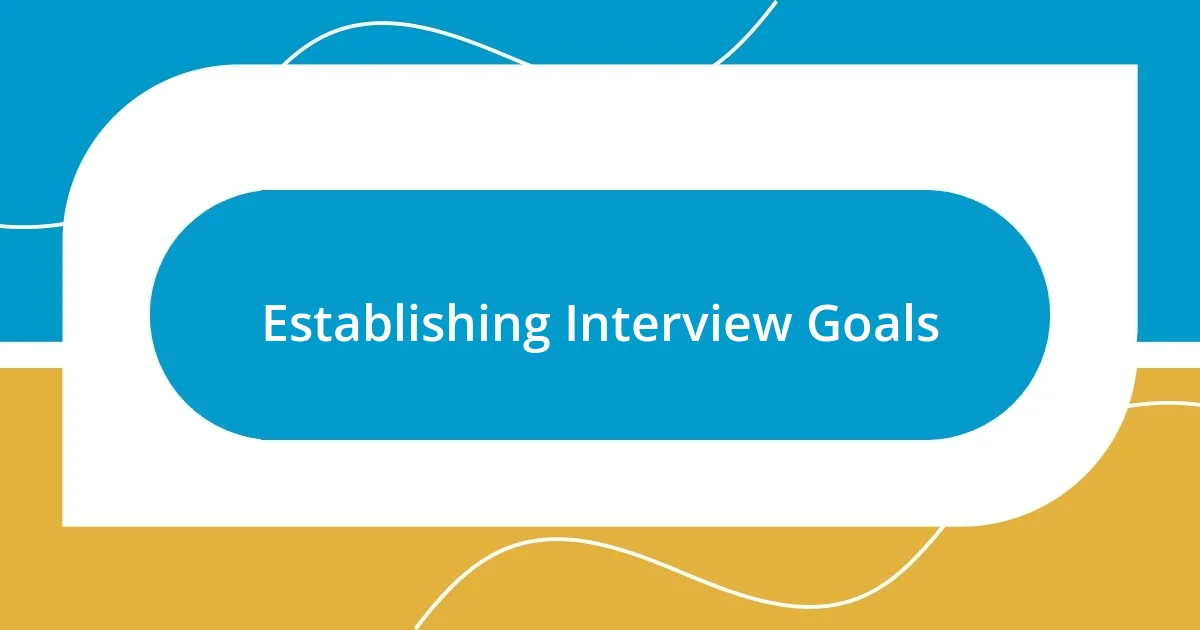
Establishing Interview Goals
Establishing clear goals for your user interviews is essential; it sets the stage for what you want to achieve. I’ve learned that if I don’t define my objectives upfront, I risk wandering off course during the conversation. One time, I approached an interview without specific goals, and I ended up gathering a ton of irrelevant information that didn’t serve any purpose. It was frustrating to realize that I had wasted both my time and the participant’s.
To effectively establish interview goals, I recommend considering the following points:
- Identify Key Insights: What specific user behaviors or preferences do you want to explore?
- Set Measurement Criteria: How will you know if you’ve obtained useful information? Define metrics for success.
- Tailor Your Questions: Craft questions that are aligned with your goals; this will keep the conversation focused and productive.
- Include a mix of open and closed questions: While open questions invite deeper exploration, closed ones can help quantify results.
- Prioritize Topics: Determine which areas are most critical to investigate, ensuring that your time is spent effectively.
By honing in on these factors, I’ve noticed that my interviews yield richer insights and lead to more meaningful user interactions. Each session then becomes purposeful, with both the interviewer and interviewee feeling a sense of direction.
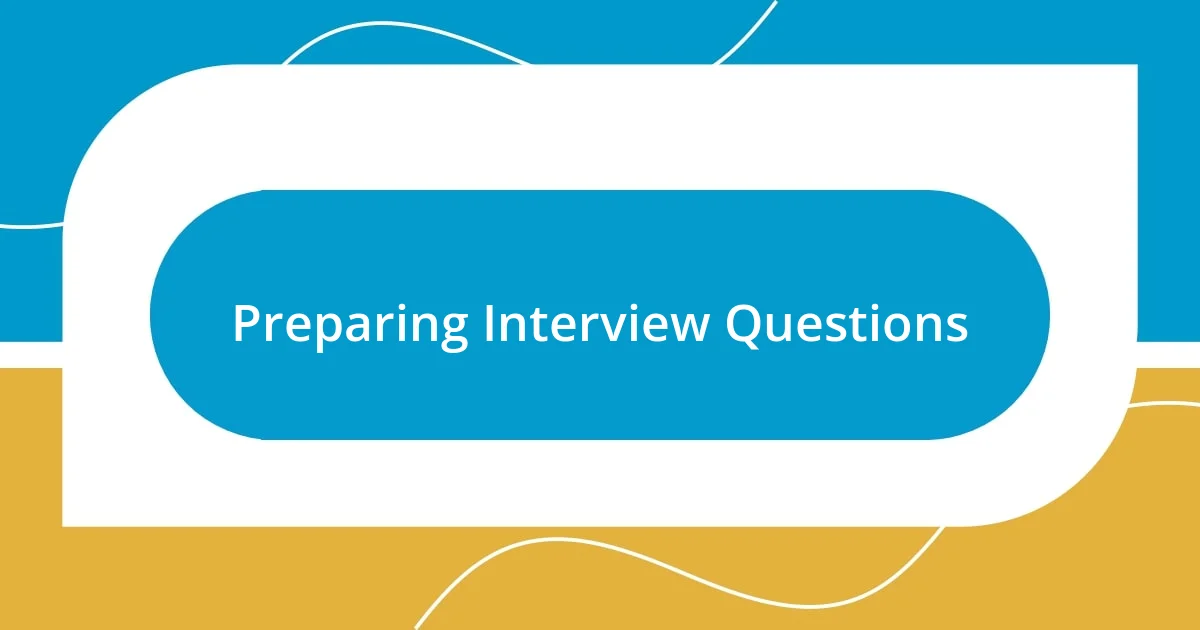
Preparing Interview Questions
When preparing interview questions, I find it essential to prioritize clarity. I once spent hours crafting what I thought were brilliant questions, only to realize they were too complex for users to understand. It left me feeling a bit defeated, but it taught me a valuable lesson: simplicity reigns supreme. Every question should be direct and allow the participant to express their thoughts without confusion.
It’s also crucial to consider the flow of the conversation. I learned the hard way that rigid scripting can stifle genuine dialogue. During one of my early interviews, I felt too tied to my list and missed spontaneous moments that could have deepened the discussion. Now, I create a flexible framework of questions, ensuring I can pivot based on the participant’s responses. This adaptability opens pathways to insights I might not have anticipated.
For me, mixing question types is another vital aspect. I visualize it like seasoning a dish—too much of one ingredient can overwhelm. While open-ended questions encourage storytelling, sometimes a closed question can quickly clarify a point. I recall an insightful session where I asked a straightforward question about daily habits—eyes lit up when I included a follow-up that allowed for elaboration! Striking that balance is a skill I continually refine.
| Question Type | Purpose |
|---|---|
| Open-ended | Encourages detailed responses |
| Closed | Gathers quantitative data |
| Follow-up | Digs deeper into initial answers |
| Probing | Explores motivations or feelings |
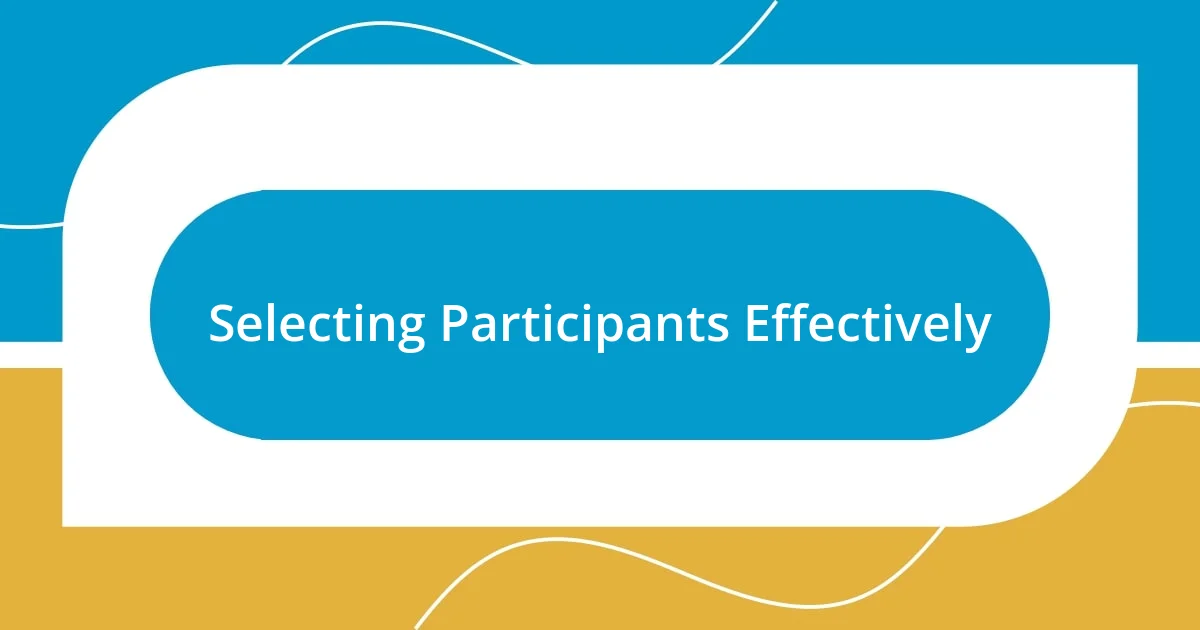
Selecting Participants Effectively
Selecting participants effectively is the backbone of a successful user interview. From my experience, the key lies in defining your target audience clearly. I once conducted interviews with users who were too far removed from the product, thinking they might offer unique perspectives. Instead, they provided feedback that was completely irrelevant, leaving me questioning my entire approach. This taught me the importance of directly aligning participant selection with the goals of my research.
Diversity in participant selection also plays a pivotal role. Different perspectives can unveil insights I hadn’t considered. I remember a session where I included both veterans and newcomers to a software tool. The experienced users shared intricate workflows, while the newcomers highlighted simplicity that the veterans had overlooked. It was fascinating to see how their varied experiences shaped the conversation, enriching my understanding immensely. Have you ever thought about how varying levels of expertise can uncover hidden truths?
Lastly, I believe in the power of rapport—finding participants who are not only suitable but also willing to open up. It sometimes takes more than just ticking boxes on a criteria list. I recall a time when I was able to establish a connection with a participant who initially seemed hesitant. Through building a little bit of trust, their insights came pouring out, leading to a deeply rewarding interview. This taught me that genuine engagement can turn a standard interview into a powerful dialogue.
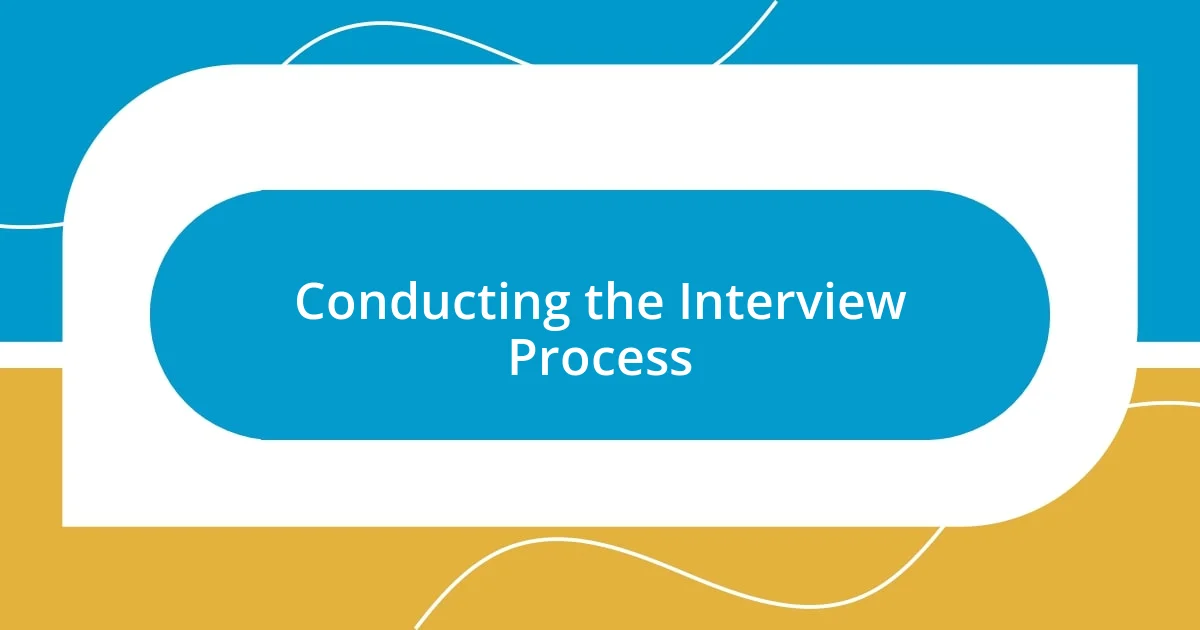
Conducting the Interview Process
Conducting the interview process is where the magic truly happens. I remember sitting across from a participant who seemed understandably nervous. To ease the tension, I shared a bit about myself and my motivations for the interview. Almost instantly, I noticed them relax, which significantly improved the quality of our conversation. Connecting on a human level can pave the way for more authentic and meaningful insights.
As the interview unfolds, listening is just as crucial as asking questions. I learned this during a session when I asked a question about user pain points. Instead of jumping in with follow-up queries, I took a moment to let silence linger. That pause encouraged the participant to elaborate, revealing frustrations I hadn’t considered before. Have you ever noticed how the best insights often come after you stop talking? It’s a simple yet powerful reminder about the value of active listening.
Keeping the interview flow natural is something I continue to practice. I’ve found that occasionally veering off-script can lead to some of the most compelling discussions. During one interview, I followed a casual remark about a recent update that my participant found frustrating. This unexpected detour led us into a valuable conversation about potential improvements. It was a great lesson on embracing the organic path of dialogue, allowing the participant’s narratives to shape the discussion more than my preset agenda.
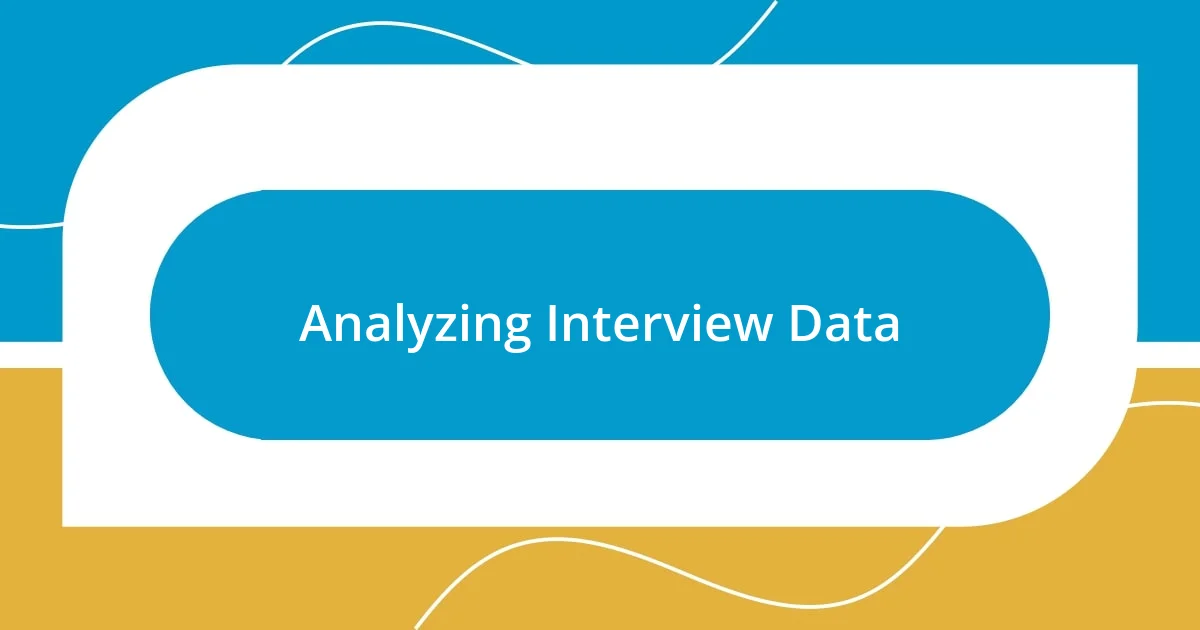
Analyzing Interview Data
When it comes to analyzing interview data, I often start by immersing myself in the transcripts. I remember the first time I reviewed my notes after an intense session; I felt like I was rediscovering the conversation anew. There’s something powerful about revisiting those words—ideas and emotions leap off the page, often revealing patterns I hadn’t noticed during the actual interview. Have you tried uncovering hidden gems in your notes? It’s surprising how much context can shift once we step away and return with fresh eyes.
Next, organizing data into meaningful categories is essential. I like to use affinity mapping, where I jot down key quotes or concepts on sticky notes and group them based on themes. This method allows me to visualize connections and contrasts between different participants’ insights. Once, during a project aimed at improving user onboarding, I laid out all the feedback side by side. Seeing it visually, I clearly identified overlapping pain points and unique suggestions, making it much clearer where to focus my efforts. Isn’t it fascinating how visual organization can simplify complex data?
Lastly, reflecting on the emotional tone behind the feedback is invaluable. I often consider how participants felt as they shared their experiences. One particularly candid interview left me struck by a participant’s frustration—they mentioned a feeling of helplessness when using the product. This wasn’t just about the features, but something deeper: a relationship with the tool itself. Recognizing these emotions helps me empathize with users and prioritize changes that resonate on a human level. Have you ever felt a similar connection with your interviewees? It’s moments like these that transform raw data into actionable insights.
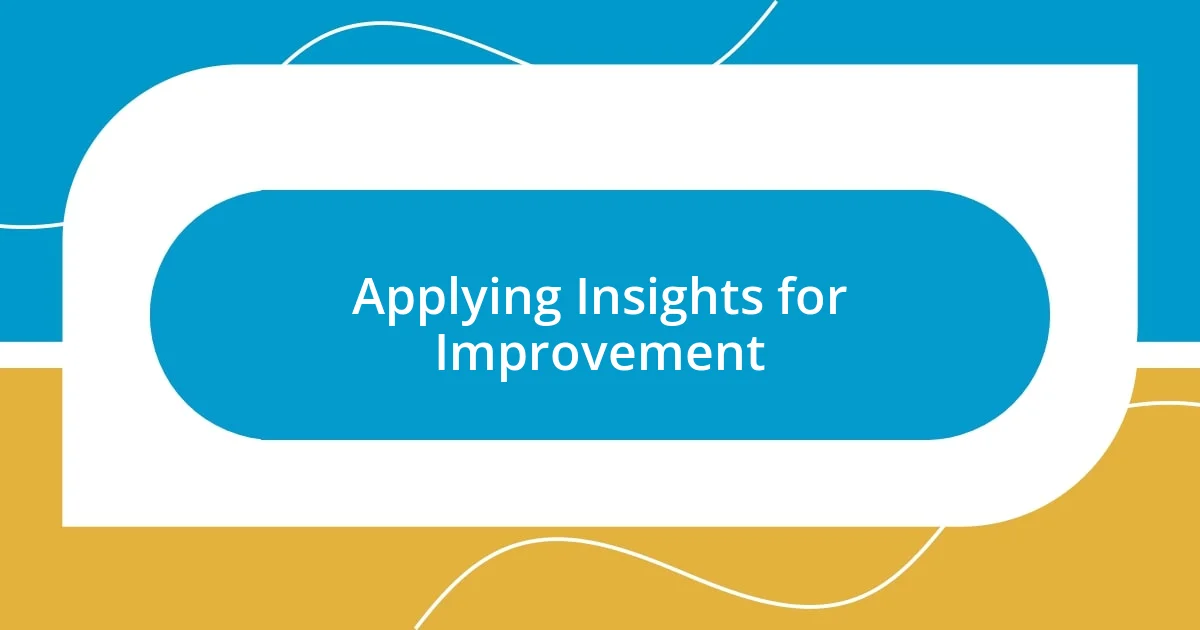
Applying Insights for Improvement
Being able to apply insights from user interviews requires a delicate balance of analysis and empathy. One time, after analyzing feedback on a feature I was excited about, I discovered that users felt it was confusing. Instead of dismissing their concerns, I sat down with my team and shared these insights, emphasizing the emotional weight behind their words. How do we ensure their viewpoints shape our design choices? By making adjustments that directly address these concerns, we redefined an important aspect of our project, ultimately turning confusion into clarity.
Moving beyond just product changes, I find that applying insights often involves rethinking our communication strategies. I recall a time when participants expressed frustration with how updates were conveyed. Their feedback revealed that better transparency could foster user trust. After implementing a more open communication line about updates and changes, I saw a noticeable improvement in user engagement. Have you ever realized that effective communication can be just as impactful as product features? Sometimes, it is those small adjustments in approach that lead to significant user satisfaction.
Finally, the most profound transformations often stem from recurring themes I pick up during interviews. In one particular instance, several users voiced a shared desire for a more social aspect of our service. This was a lightbulb moment for me! Instead of just noting their suggestions, I initiated brainstorming sessions focused on community-building features. What started as user feedback morphed into a project that brought users together in ways I hadn’t expected. Isn’t it remarkable how the insights we gather can spark new ideas and opportunities for growth? The key lies in being open to evolution, both in products and in how we connect with our users.












